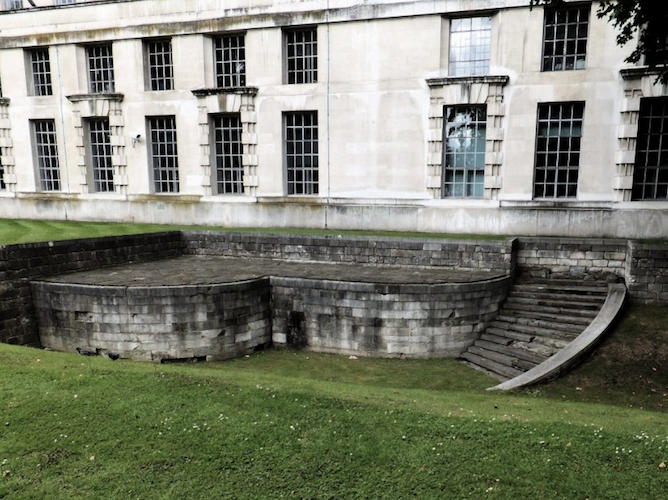Every day thousands of people travel through a street in central London unaware that they are walking through what is almost certainly the biggest single part of Lost London. Of all the buildings that have been lost to the capital none can compete – at least in size – with Henry VIII’s Palace of Westminster. He moved there in 1529 when the historic Palace of Westminster was destroyed by fire. It is marked today as Old Palace Yard behind the ancient Westminster Hall,
The new Palace occupied both sides of Whitehall from today’s Parliament Square almost to Charing Cross. It was to be the main residence of the monarch and in historian Simon Thurley’s words “the epicentre of the main events in England for nearly two centuries”.
It dominated the entire area with a startling 1,500 rooms making it bigger – and much uglier – than Louis lV’s Versailles or the Vatican. In its defence, Louis had the advantage of planning from scratch whereas Whitehall Palace was assembled in a spatchcock way from Cardinal Wolsey’ sequestered York Palace. In addition to government offices, hospitality functions and dwellings for nobles it included a bowling green, a cockpit (behind today’s number 70 Whitehall), a tennis court and a jousting yard in Horse Guards Parade.
The Victorian historian Augustus J Hare reminds us that Henry “obtained an act of parliament enacting that “the entire space between Charing Cross and the sanctuary at Westminster, from the Thames on the east side to the park wall westward, should from henceforth be deemed the Kings whole Palace of Westminster“. Bad luck if you owned a house in the way.
And what is visible today? Nothing at all apart from Inigo Jones’s majestic Banqueting Hall which was in any case a later addition in 1607 and the remnants of Queen Mary ll’s steps to the Thames (above) which were re-designed on a Tudor original in 1691 by Sir Christopher Wren.
The only bits that have survived are invisible to the public eye. The most dramatic is Cardinal Wolsey’s wine cellar – appropriated along with the Cardinal’s other property by Henry which has been preserved somewhat bizarrely under the Ministry of Defence building in Horse Guards Avenue. It is sadly not open to the public unless you have a bit of luck. Part of the wall of Henry’s tennis court has been incorporated into a wall of the Treasury and a reconstructed Cockpit is also in the bowels of the building.
Looking at the 1570 Agas map (above) you get a good idea what Whitehall was like. Two gatehouses straddled the road to connect the eastern and western parts of the palace of which the Holbein Gate (to the north) was reckoned to have been more picturesque than the Westminster Gate to the south.
Historians mainly write about governance and architecture but rarely about the people who lived here partly to service the needs of the court and Abbey. If they wanted to get to the village of Charing they would have had to walk through the royal palace and between the two gateways as there was no other way, Henry appropriated St James’s Park for his own use including the leper hospital purchased from Eton College (to become St James’s Palace). The only alternative was to pay for a wherry to take you along the Thames.
Henry VIII’s Whitehall Palace met a sorry end in 1698 when it was accidently burned down by a servant airing linen too close to a fire. A royal residence destroyed twice by fire is beginning to look a bit spooked. But there is one happy exception to this. Although Henry’s two later palaces were destroyed key parts of the one he vacated in 1530 are still there.
The marvellous Westminster Hall started by William Rufus (1056 – 1100) with what is believed still to be the biggest hammer beam roof in the world, is still there in all its glory as is Edward lll’s Jewel Tower which is now a fine outdoor café as well as a bijoux museum. They are both on Thorney Island formed by the confluence of the River Tyburn, now lost underground in the sewage system, but which still rolls down from the Hampstead hills to meet the Thames. Also on Thorney Island are both houses of Parliament, Westminster Abbey and Westminster School, arguably the biggest concentration of “history’ in the country.
All previous instalments of Vic Keegan’s Lost London can be found here and a book containing many of them can be bought here. Follow Vic on Twitter and also as @LondonStreetWalker.
On London strives to provide more of the kind of journalism the capital city needs. Become a supporter for just £5 a month. You will even get things for your money. Details here.
